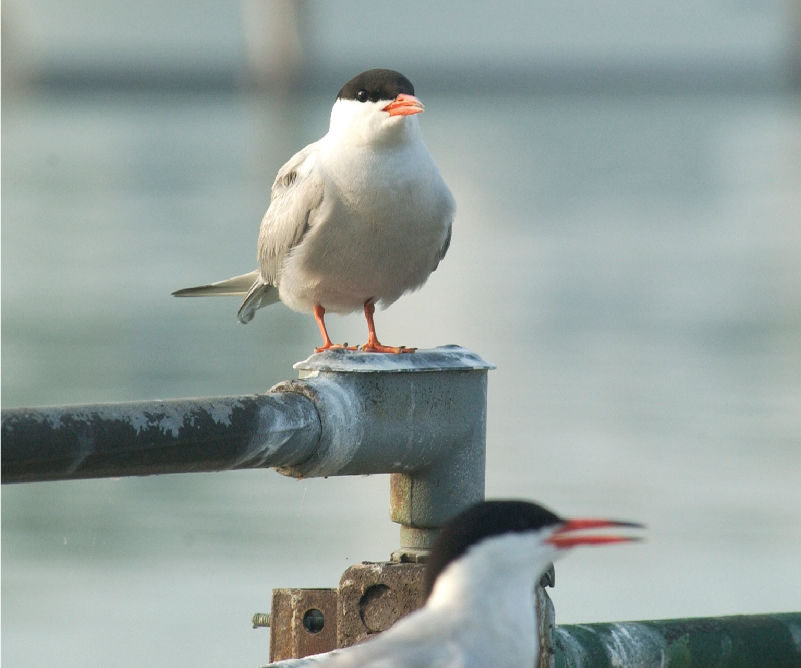Animals & Plants
Building a clean energy future is a core mission of our company, so we work with environmental partners to create or rehabilitate habitats. These efforts ensure animals and plants have an ideal place to live.
A number of endangered or rare species have found a home at DTE Energy facilities. We also strive to eliminate invasive species, foreign plants and animals that tend to crowd out species native to Michigan.
Endangered Species
Peregrine Falcons
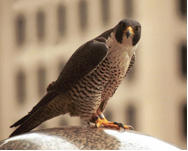 Since the mid-1990s, DTE Energy has supported peregrine falcon (Falco peregrinus) reintroduction and breeding programs in southeastern Michigan. Offering trained personnel and equipment, such as bucket trucks, we help biologists from the Michigan Department of Natural Resources and Environment to monitor nesting peregrines in the City of Detroit and those near our power plants. Our employees assist with banding, tracking and rescuing at-risk chicks. Peregrines have been recorded nesting on the Monroe Power Plant grounds since 1994.
Since the mid-1990s, DTE Energy has supported peregrine falcon (Falco peregrinus) reintroduction and breeding programs in southeastern Michigan. Offering trained personnel and equipment, such as bucket trucks, we help biologists from the Michigan Department of Natural Resources and Environment to monitor nesting peregrines in the City of Detroit and those near our power plants. Our employees assist with banding, tracking and rescuing at-risk chicks. Peregrines have been recorded nesting on the Monroe Power Plant grounds since 1994.
Bald Eagles
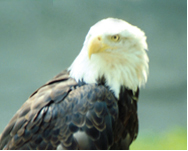 DTE Energy facilities are home to many bald eagles. Over 100 eagles, adults and juveniles, have been counted near the shoreline at the Monroe Power Plant. Eagles have also nested regularly at our Fermi 2 Power Plant.
DTE Energy facilities are home to many bald eagles. Over 100 eagles, adults and juveniles, have been counted near the shoreline at the Monroe Power Plant. Eagles have also nested regularly at our Fermi 2 Power Plant.
DTE Electric apprentice linemen installed utility poles in various bird projects, such as eagle habitat at the Lake Erie Metropark and Humbug Island within the Detroit River International Wildlife Refuge, as well as a great blue heron rookery at Lyon Oaks County Park. These projects foster the bird population while giving apprentice linemen experience in installing tall poles without energized lines or power transmission equipment.
American Lotus
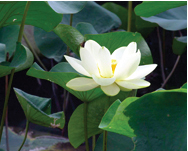 Located between the Raisin River and Plum Creek on a 1,000-acre tract, the Monroe Power Plant is home to the American lotus (Nelumbo lutea). Listed as a threatened species in Michigan, this aquatic plant grows in quiet waters in ponds, lakes and the edges of slow moving streams and rivers. It produces a magnificent pale yellow flower that blooms in mid to late summer. The plant naturally cleans the water in which it lives, which is important for the native fish and wildlife. In partnership with the Lotus Garden Club of Monroe, DTE Energy opens the Monroe Power Plant property for guided tours of the flowerbeds.
Located between the Raisin River and Plum Creek on a 1,000-acre tract, the Monroe Power Plant is home to the American lotus (Nelumbo lutea). Listed as a threatened species in Michigan, this aquatic plant grows in quiet waters in ponds, lakes and the edges of slow moving streams and rivers. It produces a magnificent pale yellow flower that blooms in mid to late summer. The plant naturally cleans the water in which it lives, which is important for the native fish and wildlife. In partnership with the Lotus Garden Club of Monroe, DTE Energy opens the Monroe Power Plant property for guided tours of the flowerbeds.
Lake Sturgeon
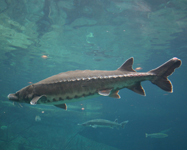 Sturgeon are the longest-living fish species in Michigan, with a lifespan up to 100 years. They can be over eight feet in length and weigh 800 pounds.
Sturgeon are the longest-living fish species in Michigan, with a lifespan up to 100 years. They can be over eight feet in length and weigh 800 pounds.
The lake sturgeon is listed as threatened or endangered by 19 of the 20 states within their original range in the United States. Many federal, state and local agencies have worked to rehabilitate lake sturgeon in the waterways connecting Lakes Huron and Erie.
Coal cinders, cobble and broken limestone were deposited in the Detroit River off Belle Isle to create spawning beds. DTE Energy provided 765 tons of coal cinders, also known as “bottom ash,” one of the by-products of the coal combustion process used to generate electricity. The material was chosen as one of the substrates because research has shown that sturgeon successfully spawned on coal cinder beds dropped in the Great Lakes by 19th century freighters.
Bats
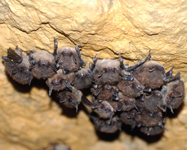 Michigan is home to nine different bat species, but each population continues to decrease every year due to human interference, loss of habitat and the spread of certain diseases or funguses, such as “white-nose syndrome.” While most bat species are not on the endangered or threatened lists, the Indiana bat (Myotis sodalis) is endangered throughout its range, which includes Michigan.
Michigan is home to nine different bat species, but each population continues to decrease every year due to human interference, loss of habitat and the spread of certain diseases or funguses, such as “white-nose syndrome.” While most bat species are not on the endangered or threatened lists, the Indiana bat (Myotis sodalis) is endangered throughout its range, which includes Michigan.
Bats, by the way, make great neighbors. A single bat can eat as many as 8,000 mosquitoes in one night. Increasing bat habitats can be a natural and environmentally friendly approach to mosquito management and can reduce diseases transmitted by these insects. DTE Energy has installed dozens of bat houses on community and company-owned property. We also support the Organization for Bat Conservation.
Common Terns
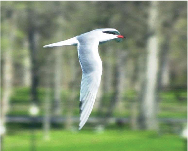 Once numbering in the thousands along the Detroit River, now only 250 breeding pairs of the common tern (Sterna hirundo) can be found there. DTE Energy partnered with a teacher from Southgate Anderson High School, Friends of the Detroit River, the U.S. Fish and Wildlife Service and Grosse Ile Nature and Land Conservancy to help the common tern make a comeback.
Once numbering in the thousands along the Detroit River, now only 250 breeding pairs of the common tern (Sterna hirundo) can be found there. DTE Energy partnered with a teacher from Southgate Anderson High School, Friends of the Detroit River, the U.S. Fish and Wildlife Service and Grosse Ile Nature and Land Conservancy to help the common tern make a comeback.
Common terns prefer to nest in riverine gravel beds, so the project partners created an artificial nesting island around a bridge pylon located near the Trenton Channel Power Plant using crushed limestone. We have also created a common tern nesting habitat at the River Rouge Power Plant.
Invasive Species
Emerald Ash Borer
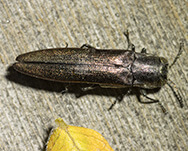 Since its discovery in 2002, the emerald ash borer (Agrilus planipennis) has killed tens of millions of ash trees in southeastern Michigan and tens of millions more in neighboring states and provinces. Quarantines were enacted in multiple states to restrict potentially infested ash trees, logs or firewood from moving out of areas where the beetle has been found. The process of removing dead trees, planting other species and managing the infestation has cost municipalities, property owners, nursery operators and forest industries tens of millions of dollars.
Since its discovery in 2002, the emerald ash borer (Agrilus planipennis) has killed tens of millions of ash trees in southeastern Michigan and tens of millions more in neighboring states and provinces. Quarantines were enacted in multiple states to restrict potentially infested ash trees, logs or firewood from moving out of areas where the beetle has been found. The process of removing dead trees, planting other species and managing the infestation has cost municipalities, property owners, nursery operators and forest industries tens of millions of dollars.
The emerald ash borer comes from Asia. The adult beetles nibble on ash foliage, but cause little damage. The larvae—the immature stage of the beetle—feeds on the inner bark, disrupting the tree's ability to transport water and nutrients. Infested trees are killed rapidly.
Dead or weakened ash trees are more susceptible to toppling or breaking during a storm and have caused major destruction to power lines and poles. DTE Energy encourages people to remove these trees from their property. Although there is an expense involved with the removal, the potential for injury or death and damage to homes, vehicles or property is far worse.
What I Can Do
- Use only local firewood. To avoid spreading the emerald ash borer to new areas, buy or cut firewood where you’ll burn it.
- Don’t panic. If you want advice on your ash trees, choose an International Society of Arboriculture (ISA)-certified arborist or tree inspector.
- Plan ahead. Consider planting saplings of another species if your ash tree doesn’t survive.
- Spread the word. Share this information with friends and neighbors. Learn more at the Michigan Department of Agriculture & Rural Development.
Zebra Mussels
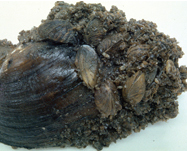 Zebra mussels are a small freshwater mollusk from Eastern Europe accidentally deposited in Lake St. Clair, probably from ballast water from a large freighter. Zebra mussels continue to plague the Detroit River and the Great Lakes today because they are very prolific and have few natural predators. They upset ecosystems, threaten native wildlife and damage manmade structures.
Zebra mussels are a small freshwater mollusk from Eastern Europe accidentally deposited in Lake St. Clair, probably from ballast water from a large freighter. Zebra mussels continue to plague the Detroit River and the Great Lakes today because they are very prolific and have few natural predators. They upset ecosystems, threaten native wildlife and damage manmade structures.
As they grow, zebra mussels attach themselves to hard surfaces, including DTE Energy power plant water intake and outfalls. Divers must regularly scrape the mussels off equipment to prevent the pipes from clogging and taking the plant offline. We also use chlorination and high-pressure water spraying to manage this costly and unavoidable maintenance issue.
Phragmites
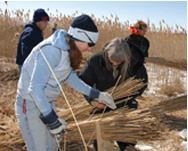 Phragmites is a tall perennial grass that can grow up to 6 meters (15 feet) tall. Subtypes of phragmites have been present in North America for thousands of years; the more aggressive European forms, however, crowd out the native varieties as well as many other marsh grasses and sedges. DTE Energy works with its environmental partners to address the problem of invasive phragmites while restoring wildlife habitat, particularly in wetland areas.
Phragmites is a tall perennial grass that can grow up to 6 meters (15 feet) tall. Subtypes of phragmites have been present in North America for thousands of years; the more aggressive European forms, however, crowd out the native varieties as well as many other marsh grasses and sedges. DTE Energy works with its environmental partners to address the problem of invasive phragmites while restoring wildlife habitat, particularly in wetland areas.
